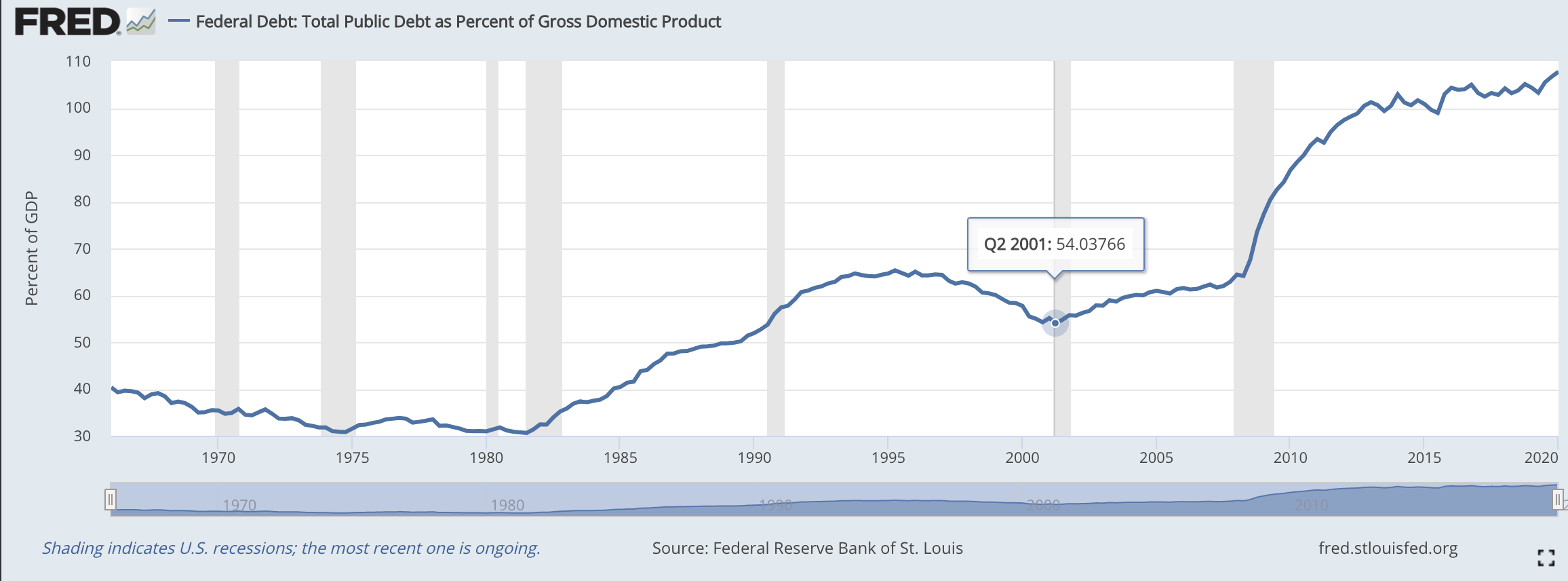1946年,,時任美國總統(tǒng)哈里?杜魯門面臨衰退的經濟狀況和第二次世界大戰(zhàn)的巨額賬單。當時美國的債務水平為GDP的119%,,這意味著其債務已經超過年度經濟總產出,。
由于龐大的聯(lián)邦開支和新冠病毒造成的經濟損失,美國今年的債務與GDP比率甚至高于這一數(shù)字,。根據(jù)美國財務咨詢網站The Balance的研究,,這一比率到第三季度末將升至136%。
該數(shù)字令人擔憂,,因為債務所產生的利息最終可能會削減國家在其他地方的支出,,比如醫(yī)療和國防等需要優(yōu)先考慮的方面。
136%這一新高數(shù)字,反映出美國自1979年以來的債務增長趨勢正在進一步加速,,當時美國債務與GDP之比為31%,。雖然債務水平在1995年至2005年之間有所下降,但圣路易斯聯(lián)邦儲備銀行的數(shù)據(jù)顯示,,美國債務的總體趨勢是穩(wěn)步上升的,。

美國當前的財政狀況不禁讓人發(fā)問,這個國家能否重現(xiàn)二戰(zhàn)后的經濟水平,?當時由于經濟快速增長,,美國的債務水平迅速降低。
不幸的是,,這種情況不太可能出現(xiàn),。大多數(shù)經濟學家認為,美國現(xiàn)在很難達到上世紀50年代超過4%的平均增長率,,原因在于國家的人口結構發(fā)生了變化,。與戰(zhàn)后時期相比,現(xiàn)在美國的人口年齡明顯增大,,這意味著年輕勞動力所占比例減少,,而他們是推動經濟發(fā)展的主體。
在經濟沒有強勢增長的情況下,,美國可能被迫削減開支,,從而避免債務問題失控。
不過從短期來看,,美國不太可能減少支出,,因其希望國家和經濟免遭新冠病毒破壞。一位專家在接受《華爾街日報》采訪時,,曾把如今的抗疫工作比作美國在二戰(zhàn)中所面臨的局面,。
“戰(zhàn)爭的類比完全正確。我們過去和現(xiàn)在都在打仗,。這次是病毒而非外國勢力,,不過消費水平不成問題?!泵绹洕檰栁瘑T會前主席格倫?哈伯德對《華爾街日報》說道,。(財富中文網)
譯者:秦維奇
1946年,時任美國總統(tǒng)哈里?杜魯門面臨衰退的經濟狀況和第二次世界大戰(zhàn)的巨額賬單,。當時美國的債務水平為GDP的119%,,這意味著其債務已經超過年度經濟總產出。
由于龐大的聯(lián)邦開支和新冠病毒造成的經濟損失,,美國今年的債務與GDP比率甚至高于這一數(shù)字。根據(jù)美國財務咨詢網站The Balance的研究,這一比率到第三季度末將升至136%,。
該數(shù)字令人擔憂,,因為債務所產生的利息最終可能會削減國家在其他地方的支出,比如醫(yī)療和國防等需要優(yōu)先考慮的方面,。
136%這一新高數(shù)字,,反映出美國自1979年以來的債務增長趨勢正在進一步加速,當時美國債務與GDP之比為31%,。雖然債務水平在1995年至2005年之間有所下降,,但圣路易斯聯(lián)邦儲備銀行的數(shù)據(jù)顯示,美國債務的總體趨勢是穩(wěn)步上升的,。
美國當前的財政狀況不禁讓人發(fā)問,,這個國家能否重現(xiàn)二戰(zhàn)后的經濟水平?當時由于經濟快速增長,,美國的債務水平迅速降低,。
不幸的是,這種情況不太可能出現(xiàn),。大多數(shù)經濟學家認為,,美國現(xiàn)在很難達到上世紀50年代超過4%的平均增長率,原因在于國家的人口結構發(fā)生了變化,。與戰(zhàn)后時期相比,,現(xiàn)在美國的人口年齡明顯增大,這意味著年輕勞動力所占比例減少,,而他們是推動經濟發(fā)展的主體,。
在經濟沒有強勢增長的情況下,美國可能被迫削減開支,,從而避免債務問題失控,。
不過從短期來看,美國不太可能減少支出,,因其希望國家和經濟免遭新冠病毒破壞,。一位專家在接受《華爾街日報》采訪時,曾把如今的抗疫工作比作美國在二戰(zhàn)中所面臨的局面,。
“戰(zhàn)爭的類比完全正確,。我們過去和現(xiàn)在都在打仗。這次是病毒而非外國勢力,,不過消費水平不成問題,。”美國經濟顧問委員會前主席格倫?哈伯德對《華爾街日報》說道,。(財富中文網)
譯者:秦維奇
In 1946, President Harry Truman confronted an economic downturn and a whopping bill for the Second World War. The country's debt level stood at 119% of GDP—meaning the U.S. owed more than its total annual economic output.
This year, as a result of massive federal spending and the economic toll of the coronavirus, the ratio of debt to GDP is even higher. According to research from The Balance, that ratio will reach 136% by the end of the third quarter.
The figure is a source of concern because interest payments on that debt could eventually crowd out other national priorities such as health or defense.
The new 136% figure reflects an acceleration of a trend that has been taking place since 1979 when the U.S. debt-to-GDP stood at 31%. While debt levels dipped between 1995 and 2005, figures from the St. Louis Federal Reserve show the overall trend has been steadily upwards:
The current fiscal situation raises the question of whether the U.S. economy will be able to replicate its performance of the years following World War II when debt levels shrunk rapidly thanks to rapid growth.
Unfortunately, that scenario is unlikely since most economists believe 1950s style growth rates, which averaged over 4%, are not achievable, in part because of the country's changed demographics. Compared to the post-war era, the U.S. population is significantly older, meaning there is a smaller share of younger workers to help drive the economy.
In the absence of strong growth, the U.S. will likely to have to rely on cutting spending in order to prevent its debt levels from becoming unmanageable.
In the short term, though, spending cuts are unlikely as the U.S. seeks to protect the country and the economy from the ravages of the coronavirus. In an interview with the Wall Street Journal, one expert likened the fight against COVID to what the U.S. faced during World War II.
“The war analogy is exactly the right one. We were and are fighting a war. It’s a virus, not a foreign power, but the level of spending isn’t the problem," Glenn Hubbard, a former chairman of the Council of Economic Advisers, told the Journal.






